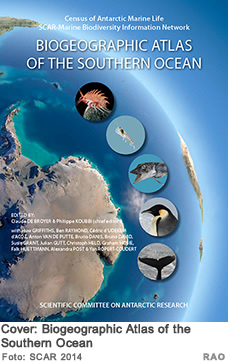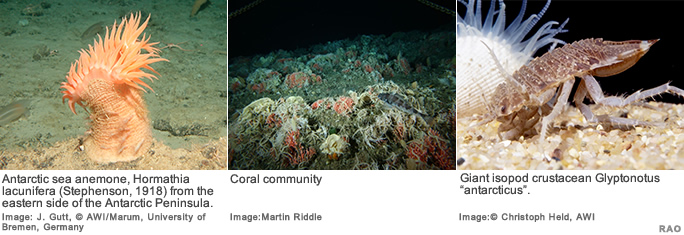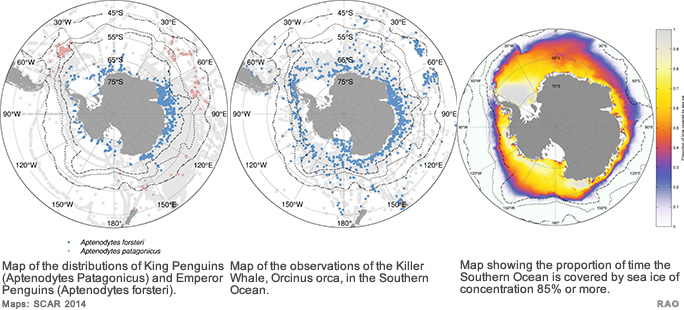 |
Polgebiete Antarktis |
 |
Polgebiete Weitere Informationen |
|
| Biogeographic Atlas of the Southern Ocean |
 |
All creatures great and small, from the mighty whale to the miniature microbe, are included in the first ever comprehensive Atlas of Southern Ocean marine life, published.
The Biogeographic Atlas of the Southern Ocean is the culmination of four years work by an international team of marine biologists and oceanographers from 22 countries, including scientists from the Australian Antarctic Division.
 |
| The 66 chapter Atlas includes more than 9.000 Southern Ocean species, 800 maps and 100 colour photos. It examines the evolution, physical environment, genetics and possible impact of climate change on Southern Ocean organisms.en abrufen - einschliesslich neu Hinzukommender."
The information contained in the Atlas is based on data collected during the Australian-led Census of Antarctic Marine Life (CAML)- a marine survey conducted during the International Polar Year in 2007- as well as data gathered from past decades of research.
CAML leader and former Chief Scientist of the Australian Antarctic Division, Dr Michael Stoddart, said Australian scientists participated in three CAML voyages off East Antarctica, which studied seafloor communities and the deep ocean. |
|
"We found that the region is unexpectedly richer in species diversity than previously known, and molecular techniques show Antarctica to be the origin of many species, Dr Stoddart said.
"For example, species of octopus that existed in Antarctica 30 million years ago have been propelled by strong north-bound currents and now colonise many parts of the Earth's oceans.
Marine scientist, Dr Graham Hosie, was one of the Australian Antarctic Division's voyage leaders for CAML and edited a number of chapters in the Atlas.
He said the Atlas would provide an up-to-date synthesis of Antarctic and subantarctic biogeographic knowledge.
 |
Antarctica |
 |
|
| "Biogeographic information is fundamentally important for discovering marine biodiversity hotspots, detecting and understanding environmental changes, monitoring biodiversity, and supporting conservation and sustainable management strategies, Dr Hosie said. |
|
"The methods and results applied in the Atlas have informed the development of proposals for marine protected areas in the region.
The Atlas will also provide a baseline for assessing future change to Antarctic marine ecosystems, including the distribution of key species as they adapt to climate change.
The Atlas is published by the Scientific Committee on Antarctic Research (SCAR) and is being launched at its Open Science conference in Auckland, New Zealand,and will be available online.
atlas website: atlas.biodiversity.aq
The Biogeographic Atlas includes the following contents:
| PART 1. INTRODUCTION |
PART 2. METHODS |
| PART 3. EVOLUTIONARY SETTING |
PART 4. ENVIRONMENTAL SETTING |
| PART 5. BIOGEOGRAPHIC PATTERNS OF BENTHOS |
PART 6. BIOGEOGRAPHIC PATTERNS OF PELAGIC AND SEA-ICE BIOTA |
| PART 7. BIOGEOGRAPHIC PATTERNS OF FISH |
PART 8. BIOGEOGRAPHIC PATTERNS OF BIRDS AND MAMMALS |
| PART 9. Changes AND CONSERVATION in The Southern ocean |
PART 10. PATTERNS AND PROCESSES OF SOUTHERN OCEAN BIOGEOGRAPHY |
| PART 11. THE DYNAMIC BIOGEOGRAPHIC ATLAS PROJECT |
 |
|
nach
oben
| Links |
 |
 |
 |
Externe Links |
|






